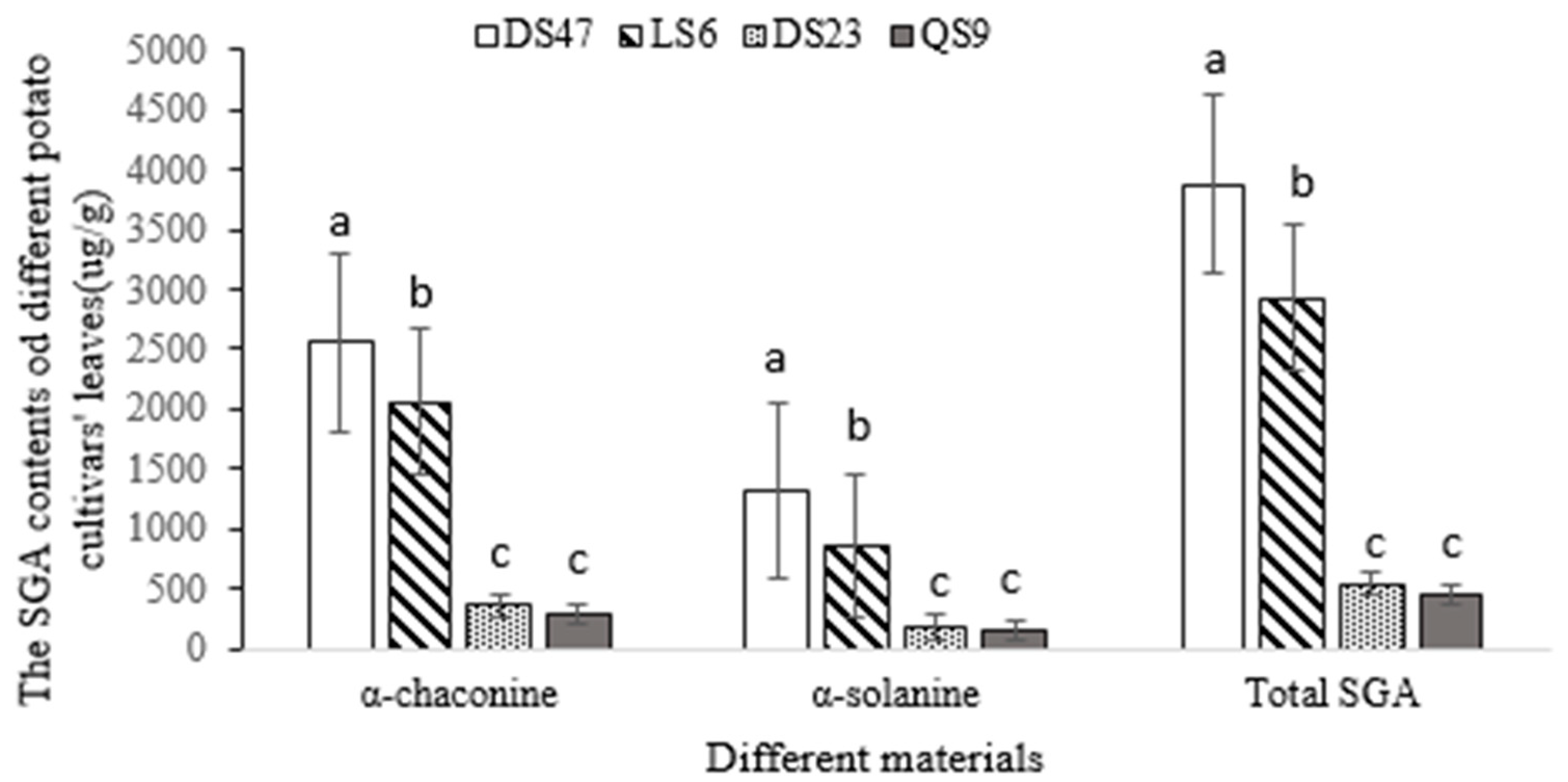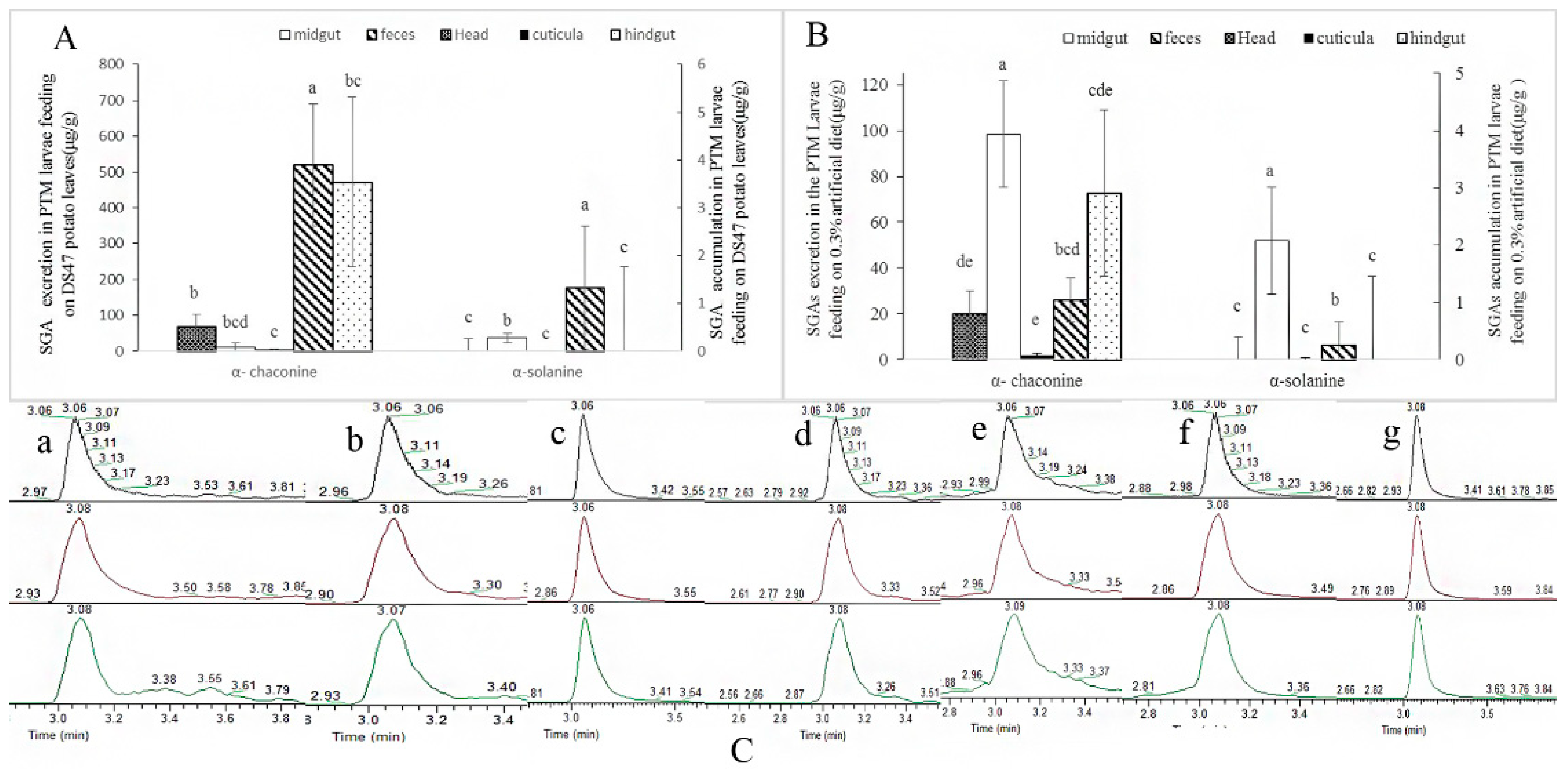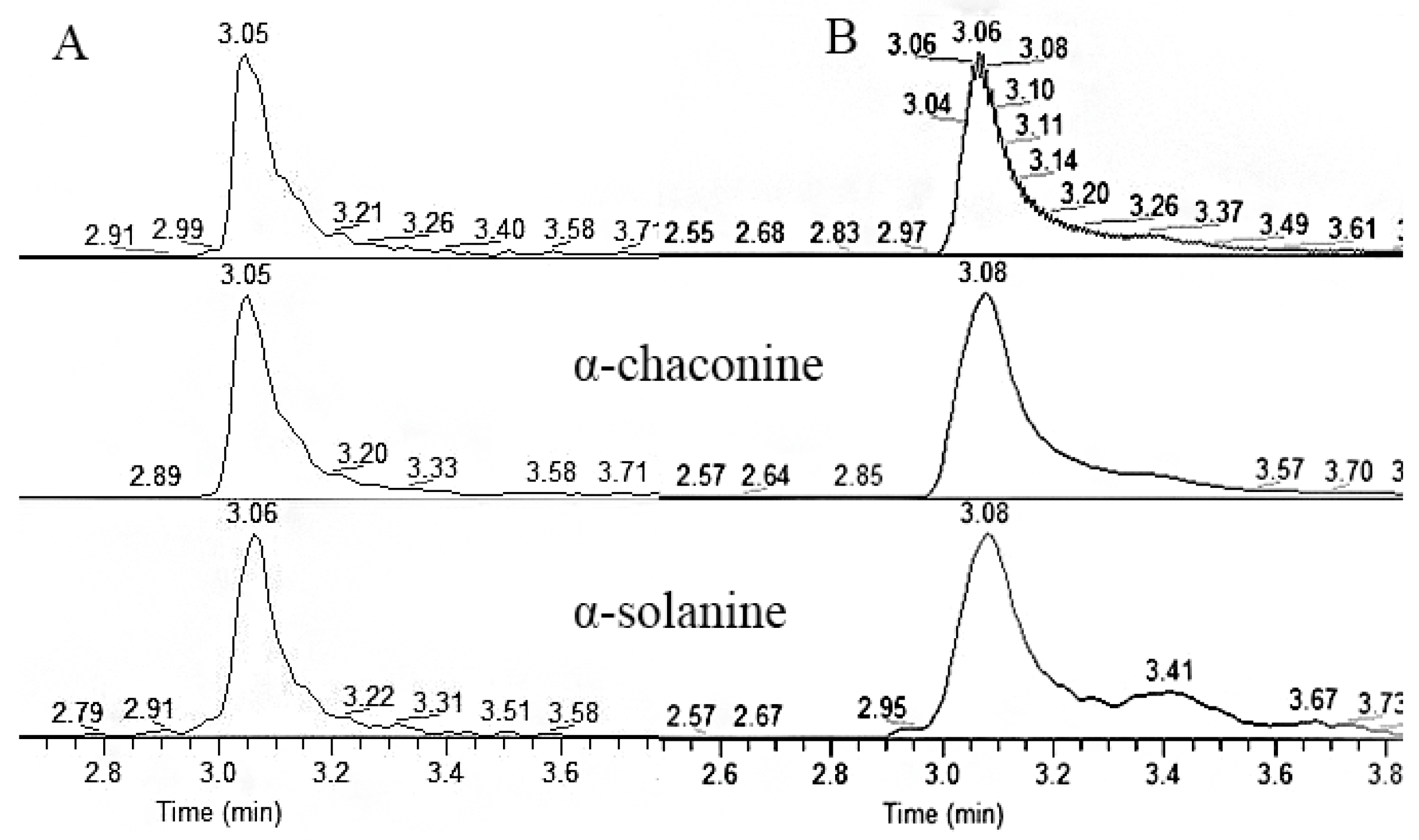UHPLC-MS/MS Analysis of the Accumulation and Excretion of Steroidal Glycoalkaloids Consumed by Potato Tuber Moth (Phthorimaea operculella) Larvae under Different Feeding Treatments
Abstract
Simple Summary
Abstract
1. Introduction
2. Materials and Methods
2.1. Plant Materials
2.2. Insect Rearing Method
2.2.1. Potato Tuber Moth Feeding on Potato Leaves
2.2.2. Potato Tuber Moth Feeding on Artificial Diet
2.2.3. Potato Tuber Moth Feeding on Antibiotic Artificial Diet
2.3. Sample Preparation
2.4. Ultrahigh-Performance Liquid Chromatography-Triple Quadrupole Mass Spectrometry Analysis
2.5. Data Analysis
3. Results
3.1. Effects of Different Potato Varieties on the Growth and Reproduction of Potato Tuber Moths
3.1.1. SGA Concentrations of Different Potato Varieties
3.1.2. Effects of Different Potato Varieties on the Growth and Reproduction of Potato Tuber Moths
3.2. Effects of Different SGAs Containing an Artificial Diet on the Growth and Reproduction of Potato Tuber Moths
3.3. SGA Accumulation and Excretion in Potato Tuber Moth Larvae
3.3.1. Excretion and Accumulation of SGA in Potato Tuber Moth Larvae Feeding on Potato Leaves
3.3.2. SGA Accumulation and Excretion in PTM Larvae Feeding on Artificial Diet
3.4. Detoxification of SGAs in the Midgut of Potato Tuber Moth Larvae
3.5. The SGA Heredity of Potato Tuber Moth
4. Conclusions
5. Discussion
Author Contributions
Funding
Institutional Review Board Statement
Informed Consent Statement
Data Availability Statement
Acknowledgments
Conflicts of Interest
References
- Kroschel, J.; Mujica, N.; Okonya, J.; Alyokhin, A. Insect pests affecting potatoes in tropical, subtropical, and temperate regions. In The Potato Crop; Springer: Cham, Switzerland, 2020; pp. 251–306. [Google Scholar]
- Rondon, S.I. The potato tuberworm: A literature review of its biology, ecology, and control. Am. J. Potato Res. 2010, 87, 149–166. [Google Scholar] [CrossRef]
- Gao, Y. Green control techniques for potato tuberworm (Phthorimaea operculella). Sci. Agric. Sin 2021, 54, 533–535. [Google Scholar]
- Yan, J.; Zhang, M.; Gao, Y. Biology, ecology and integrated management of the potato tuber moth, Phthorimaea operculella (Lepidoptera: Gelechiidae). Acta Entomol. Sin. 2019, 62, 1469–1482. [Google Scholar]
- Gao, Y.; Alyokhin, A.; Nauen, R.; Guedes, R.N.; Palli, S.R. Challenges and opportunities in managing pests of potato. Pest Manag. Sci. 2022, 78, 3729–3730. [Google Scholar] [CrossRef]
- Kroschel, J.; Schaub, B. Biology and ecology of potato tuber moths as major pests of potato. In Insect Pests of Potato: Global Perspectives on Biology and Managemen; Elsevier: Oxford, UK, 2013; pp. 165–192. [Google Scholar]
- Zeng, F.K.; Xu, D.; Liu, G. Potato Nutrition: A Critical Review. Chin. Potato J. 2015, 29, 233–243. [Google Scholar]
- Aloo, B.; Mbega, E.; Makumba, B. Rhizobacteria-based technology for sustainable cropping of potato (Solanum tuberosum L.). Potato Res. 2020, 63, 157–177. [Google Scholar] [CrossRef]
- Friedman, M. Potato glycoalkaloids and metabolites: Roles in the plant and in the diet. J. Agric. Food Chem. 2006, 54, 8655–8681. [Google Scholar] [CrossRef]
- Deng, M.; Zhang, J.; Tang, X.; Yang, L.; Yu, W.; Zhu, Y.; Yu, L.; Wang, X. Research progress of Solanine in potato. Mol. Plant Breed. 2019, 7, 2399–2407. [Google Scholar]
- Friedman, M.; McDonald, G.M.; Filadelfi-Keszi, M. Potato glycoalkaloids: Chemistry, analysis, safety, and plant physiology. Crit. Rev. Plant Sci. 1997, 16, 55–132. [Google Scholar] [CrossRef]
- Ginzberg, I.; Tokuhisa, J.G.; Veilleux, R.E. Potato steroidal glycoalkaloids: Biosynthesis and genetic manipulation. Potato Res. 2009, 52, 1–15. [Google Scholar] [CrossRef]
- Nielsen, S.D.; Schmidt, J.M.; Kristiansen, G.H.; Dalsgaard, T.K.; Larsen, L.B. Liquid chromatography mass spectrometry quantification of α-solanine, α-chaconine, and solanidine in potato protein isolates. Foods 2020, 9, 416. [Google Scholar] [CrossRef] [PubMed]
- Milner, S.E.; Brunton, N.P.; Jones, P.W.; O’Brien, N.M.; Collins, S.G.; Maguire, A.R. Bioactivities of glycoalkaloids and their aglycones from Solanum species. J. Agric. Food Chem. 2011, 59, 3454–3484. [Google Scholar] [CrossRef]
- Zhao, D.K.; Zhao, Y.; Chen, S.Y.; Kennelly, E.J. Solanum steroidal glycoalkaloids: Structural diversity, biological activities, and biosynthesis. Nat. Prod. Rep. 2021, 38, 1423–1444. [Google Scholar] [CrossRef] [PubMed]
- Sinani, S.; Eltayeb, E.A.; Kamal, Y.; Khan, M.S.; Ahmad, S. Variations in the cytotoxic glycoalkaloids solamargine and solasonine in different parts of the Solanum incanum plant during its growth and development in Oman. J. Taibah Univ. Sci. 2016, 10, 813–822. [Google Scholar] [CrossRef][Green Version]
- Knuthsen, P.; Jensen, U.; Schmidt, B.; Larsen, I.K. Glycoalkaloids in potatoes: Content of glycoalkaloids in potatoes for consumption. J. Food Compos. Anal. 2009, 22, 577–581. [Google Scholar] [CrossRef]
- Elsayed, G. Plant secondary substances and insects behaviour. Arch. Phytopathol. Plant Prot. 2011, 44, 1534–1549. [Google Scholar] [CrossRef]
- Pulgar, J.S.d.; Lucarini, M.; Aguzzi, A.; Gabrielli, P.; Parisi, B.; Pacifico, D.; Mandolino, G.; Lombardi-Boccia, G. Glycoalkaloid Content in Italian Potato Breeding Clones Improved for Resistance against Potato Tuber Moth (Phthorimaea operculella Zeller). Potato Res. 2021, 64, 229–240. [Google Scholar] [CrossRef]
- Perkovich, C.; Ward, D. Differentiated plant defense strategies: Herbivore community dynamics affect plant–herbivore interactions. Ecosphere 2022, 13, e3935. [Google Scholar] [CrossRef]
- Akhtar, Y.; Isman, M.B. Binary mixtures of feeding deterrents mitigate the decrease in feeding deterrent response to antifeedants following prolonged exposure in the cabbage looper, Trichoplusia ni (Lepidoptera: Noctuidae). Chemoecology 2003, 13, 177–182. [Google Scholar] [CrossRef]
- Green, E.; Zangerl, A.; Berenbaum, M. Effects of phytic acid and xanthotoxin on growth and detoxification in caterpillars. J. Chem. Ecol. 2001, 27, 1763–1773. [Google Scholar] [CrossRef]
- Wheeler, G.; Slansky Jr, F.; Yu, S. Food consumption, utilization and detoxification enzyme activity of larvae of three polyphagous noctuid moth species when fed the botanical insecticide rotenone. Entomol. Exp. Et Appl. 2001, 98, 225–239. [Google Scholar] [CrossRef]
- Schoonhoven, L.M.; Van Loon, J.J.; Dicke, M. Insect-Plant Biology; Oxford University Press on Demand: Oxford, UK, 2005. [Google Scholar]
- Ali, J.G.; Agrawal, A.A. Specialist versus generalist insect herbivores and plant defense. Trends Plant Sci. 2012, 17, 293–302. [Google Scholar] [CrossRef] [PubMed]
- Altesor, P.; García, Á.; Font, E.; Rodríguez-Haralambides, A.; Vilaró, F.; Oesterheld, M.; Soler, R.; González, A. Glycoalkaloids of wild and cultivated Solanum: Effects on specialist and generalist insect herbivores. J. Chem. Ecol. 2014, 40, 599–608. [Google Scholar] [CrossRef]
- Schowalter, T.D. Insect Ecology: An Ecosystem Approach; Academic Press: Cambridge, MA, USA, 2022. [Google Scholar]
- Pacifico, D.; Musmeci, S.; del Pulgar, J.S.; Onofri, C.; Parisi, B.; Sasso, R.; Mandolino, G.; Lombardi-Boccia, G. Caffeic acid and α-chaconine influence the resistance of potato tuber to Phthorimaea operculella (Lepidoptera: Gelechiidae). Am. J. Potato Res. 2019, 96, 403–413. [Google Scholar] [CrossRef]
- Iwasa, T.; Motoyama, N.; Ambrose, J.T.; Roe, R.M. Mechanism for the differential toxicity of neonicotinoid insecticides in the honey bee, Apis mellifera. Crop Prot. 2004, 23, 371–378. [Google Scholar] [CrossRef]
- Nenaah, G. Individual and synergistic toxicity of solanaceous glycoalkaloids against two coleopteran stored-product insects. J. Pest Sci. 2011, 84, 77–86. [Google Scholar] [CrossRef]
- Yuan, H.; Lei, Z.; Rondon, S.I.; Gao, Y. Potential of a strain of Beauveria bassiana (Hypocreales: Cordycipitaceae) for the control of the potato tuberworm, Phthorimaea operculella (Zeller). Int. J. Pest Manag. 2017, 63, 352–354. [Google Scholar] [CrossRef]
- Yan, J.-j.; Mei, X.-d.; Feng, J.-w.; Lin, Z.-x.; Reitz, S.; Meng, R.-x.; Gao, Y.-l. Optimization of the sex pheromone-based method for trapping field populations of Phthorimaea operculella (Zeller) in South China. J. Integr. Agric. 2021, 20, 2727–2733. [Google Scholar] [CrossRef]
- Yan, J.-J.; Sarkar, S.C.; MENG, R.-x.; Reitz, S.; GAO, Y.-l. Potential of Steinernema carpocapsae (Weiser) as a biological control agent against potato tuber moth, Phthorimaea operculella (Zeller)(Lepidoptera: Gelechiidae). J. Integr. Agric. 2020, 19, 389–393. [Google Scholar] [CrossRef]
- Self, L.; Guthrie, F.; Hodgson, E. Metabolism of nicotine by tobacco-feeding insects. Nature 1964, 204, 300–301. [Google Scholar] [CrossRef]
- Ceja-Navarro, J.A.; Vega, F.E.; Karaoz, U.; Hao, Z.; Jenkins, S.; Lim, H.C.; Kosina, P.; Infante, F.; Northen, T.R.; Brodie, E.L. Gut microbiota mediate caffeine detoxification in the primary insect pest of coffee. Nat. Commun. 2015, 6, 1–9. [Google Scholar] [CrossRef]
- Briese, D. Geographic variability in demographic performance of the potato moth, Phthorimaea operculella (Zeller)(Lepidoptera: Gelechiidae), in Australia. Bull. Entomol. Res. 1986, 76, 719–726. [Google Scholar] [CrossRef]
- Herman, T.; Clearwater, J.; Triggs, C. Impact of pheromone trap design placement and pheromone blend on catch of potato tuber moth. N. Z. Plant Prot. 2005, 58, 219–223. [Google Scholar] [CrossRef]
- Gui, F.; Li, Z. A method for rearing the potato tuber moth Phthorimaea operculella on potato. Chin. Bull. Entomol. 2003, 40, 187–189. [Google Scholar]
- Kashyap, S.; Chakrabarti, S.; Pattanayak, D.; Chandran, K.; Gautam, D.; Chandla, V.; Naik, P.S. A modified artificial diet for rearing potato tuber moth, Phthorimeae operculella (Zeller). Potato J 2008, 35, 141–146. [Google Scholar]
- Nie, X.-H.; Guo, H.-C. An ultra-high-performance liquid chromatography-triple quadrupole mass spectrometry method for the detection of steroidal glycoalkaloids in potato samples. Anal. Methods 2017, 9, 6613–6621. [Google Scholar] [CrossRef]
- Li, Y.; Guo, H.; Wang, Q. Accumulation of steroidal glycoalkaloids in different organs of different cultivars of potato. Sci. Technol. Food Ind. 2020, 41, 1–7. [Google Scholar]
- Alipour, V.; Mehrkhou, F. Effects of different potato cultivars on life history and demographic parameters of Phthorimaea operculella Zeller (Lepidoptera: Gelechiidae). Int. J. Pest Manag. 2018, 64, 365–371. [Google Scholar] [CrossRef]
- Rainio, M.J.; Margus, A.; Virtanen, V.; Lindström, L.; Salminen, J.-P.; Saikkonen, K.; Helander, M. Glyphosate-based herbicide has soil-mediated effects on potato glycoalkaloids and oxidative status of a potato pest. Chemosphere 2020, 258, 127254. [Google Scholar] [CrossRef]
- Pentzold, S.; Zagrobelny, M.; Roelsgaard, P.S.; Møller, B.L.; Bak, S. The multiple strategies of an insect herbivore to overcome plant cyanogenic glucoside defence. PLoS ONE 2014, 9, e91337. [Google Scholar] [CrossRef]
- Dow, J.A. Insect midgut function. In Advances in Insect Physiology; Elsevier: Amsterdam, The Netherlands, 1987; Volume 19, pp. 187–328. [Google Scholar]
- Wang, W.; Xiao, G.; Du, G.; Chang, L.; Yang, Y.; Ye, J.; Chen, B. Glutamicibacter halophytocola-mediated host fitness of potato tuber moth on Solanaceae crops. Pest Manag. Sci 2022, 78, 3920–3930. [Google Scholar] [CrossRef] [PubMed]
- Shen, J.; Wang, Q.; Xia, X.; You, M. Effect of antibiotics and gut bacteria on fitness of diamondback moth Plutella xylostella (L.). Acta Microbiol. Sin. 2018, 58, 1025–1035. [Google Scholar]
- Lin, X.L.; Kang, Z.W.; Pan, Q.J.; Liu, T.X. Evaluation of five antibiotics on larval gut bacterial diversity of Plutella xylostella (Lepidoptera: Plutellidae). Insect Sci. 2015, 22, 619–628. [Google Scholar] [CrossRef] [PubMed]
- Heidel-Fischer, H.M.; Vogel, H. Molecular mechanisms of insect adaptation to plant secondary compounds. Curr. Opin. Insect Sci. 2015, 8, 8–14. [Google Scholar] [CrossRef]
- Erb, M.; Robert, C.A. Sequestration of plant secondary metabolites by insect herbivores: Molecular mechanisms and ecological consequences. Curr. Opin. Insect Sci. 2016, 14, 8–11. [Google Scholar] [CrossRef]
- Feyereisen, R. Arthropod CYPomes illustrate the tempo and mode in P450 evolution Proteins and proteomics. Biochim. Et Biophys. Acta 2011, 1814, 19–28. [Google Scholar] [CrossRef]
- Zhang, M.; Cheng, X.; Lin, R.; Xie, B.; Nauen, R.; Rondon, S.I.; Zavala, J.A.; Palli, S.R.; Li, S.; Xiong, X. Chromosomal-level genome assembly of potato tuberworm, Phthorimaea operculella: A pest of solanaceous crops. Sci. Data 2022, 9, 1–11. [Google Scholar] [CrossRef]



| Cultivars | Larval Stage (d) | Instars | Larval Count | Head Capsule (mm) | Body Length (cm) | Body Weight (mg) |
|---|---|---|---|---|---|---|
| DS47 | 16.0 ± 0.62 a | 1 | 130 | 0.13 ± 0.08 bc | 0.14 ± 0.05 bc | 0.22 ± 0.04 a |
| 2 | 90 | 0.27 ± 0.03 bc | 0.22 ± 0.03 bc | 1.05 ± 0.92 a | ||
| 3 | 85 | 0.49 ± 0.11 b | 0.45 ± 0.16 a | 3.13 ± 0.90 a | ||
| 4 | 60 | 0.90 ± 0.13 a | 0.98 ± 0.12 a | 8.10 ± 1.51 a | ||
| QS9 | 12.0 ± 1.33 a | 1 | 110 | 0.17 ± 0.01 b | 0.16 ± 0.02 b | 0.18 ± 0.04 a |
| 2 | 96 | 0.3 ± 0.01 b | 0.29 ± 0.04 b | 0.65 ± 0.36 b | ||
| 3 | 80 | 0.49 ± 0.01 b | 0.46 ± 0.10 a | 1.54 ± 0.63 b | ||
| 4 | 50 | 0.88 ± 0.09 ab | 0.95 ± 0.13 a | 4.48 ± 1.60 b | ||
| LS6 | 14.5 ± 0.98 a | 1 | 127 | 0.29 ± 0.09 a | 0.28 ± 0.06 a | 0.18 ± 0.04 a |
| 2 | 80 | 0.48 ± 0.08 a | 0.43 ± 0.05 a | 1.28 ± 1.17 a | ||
| 3 | 60 | 0.69 ± 0.06 a | 0.66 ± 0.07 a | 3.63 ± 0.84 a | ||
| 4 | 50 | 1.08 ± 0.07 a | 0.97 ± 0.07 a | 7.99 ± 1.50 a | ||
| DS23 | 12.0 ± 1.02 a | 1 | 131 | 0.27 ± 0.06 a | 0.25 ± 0.04 a | 0.19 ± 0.03 a |
| 2 | 90 | 0.45 ± 0.06 a | 0.37 ± 0.03 a | 0.65 ± 0.18 b | ||
| 3 | 70 | 0.71 ± 0.0810 a | 0.58 ± 0.14 a | 2.49 ± 0.93 a | ||
| 4 | 53 | 1.04 ± 0.1237 a | 0.92 ± 0.05 a | 7.26 ± 1.13 a |
| Cultivars | Pupal Stage | Pupal Weight (mg) | Pupation Rate | Emergence Rate | Fecundity (Eggs/Female) | Egg Stage (d) | Hatchability |
|---|---|---|---|---|---|---|---|
| DS47 | 8.0 ± 0.63 a | 9.47 ± 1.39 a | 84% | 92% | 89.5 ± 60.28 a | 5.63 ± 0.00 a | 76.7 ± 6.32 a |
| QS9 | 6.0 ± 1.01 a | 7.07 ± 1.40 ab | 68% | 86% | 57 ± 36.35 b | 4.68 ± 0.04 a | 41 ± 3.11 b |
| LS6 | 7.0 ± 0.33 a | 8.29 ± 1.09 a | 80% | 90% | 79.33 ± 51.68 a | 5.01 ± 0.01 a | 61.33 ± 5.13 ab |
| DS23 | 5.5 ± 1.30 ab | 7.2 ± 1.22 a | 76.5% | 80% | 67.67 ± 44.12 a | 4.92 ± 0.06 a | 43.67 ± 2.08 b |
| Total SGA Concentration | Larval Time (d) | Pupal Weight (mg) | Pupation Rate | Emergence Rate | Sex Ratio | Fecundity | Hatchability |
|---|---|---|---|---|---|---|---|
| 0 (ck) | 7.2 ± 1.35 b | 5.23 ± 0.86 c | 41.67% | 55.00% | 6:5 | 35 ± 5.20 c | 15.01 ± 1.11 c |
| 0.1% | 9.6 ± 2.21 b | 5.89 ± 0.95 bc | 53.36% | 62% | 8:5 | 42 ± 3.31 bc | 19.48 ± 0.90 c |
| 0.2% | 14.3 ± 1.01 ab | 6.52 ± 0.65 a | 72.92% | 90.63% | 12:13 | 50 ± 4.36 b | 27.82 ± 0.37 bc |
| 0.3% | 15.3 ± 0.92 a | 8.23 ± 1.42 a | 55.83% | 95.45% | 7:11 | 70 ± 10.21 a | 57.01 ± 3.39 a |
| 0.4% | 15.8 ± 1.46 a | 6.8 ± 1.8 a | 40.21% | 46.22% | 3:7 | 29 ± 1.39 c | 8.79 ± 1.23 d |
| Experiment | Treatment | α-Chaconine in PTM Larvae Midgut, Mean ± s.e (μg/g) | α-Solanine in PTM Larvae Midgut, Mean ± s.e (μg/g) |
|---|---|---|---|
| Control | PTM—normal microbiome | 98.41 ± 1.22 a | 41.56 ± 1.12 a |
| Antibiotic | PTM—antibiotic-treated | 115.47 ± 6.53 b | 53.57 ± 1.93 a |
| Antibiotic-reinfection | PTM—antibiotic-treated, reinfected with SGA | 12.11 ± 1.08 c | 5.23 ± 0.06 b |
Disclaimer/Publisher’s Note: The statements, opinions and data contained in all publications are solely those of the individual author(s) and contributor(s) and not of MDPI and/or the editor(s). MDPI and/or the editor(s) disclaim responsibility for any injury to people or property resulting from any ideas, methods, instructions or products referred to in the content. |
© 2022 by the authors. Licensee MDPI, Basel, Switzerland. This article is an open access article distributed under the terms and conditions of the Creative Commons Attribution (CC BY) license (https://creativecommons.org/licenses/by/4.0/).
Share and Cite
Li, Y.; Wang, Q.; Xu, X.; Guo, H. UHPLC-MS/MS Analysis of the Accumulation and Excretion of Steroidal Glycoalkaloids Consumed by Potato Tuber Moth (Phthorimaea operculella) Larvae under Different Feeding Treatments. Insects 2023, 14, 26. https://doi.org/10.3390/insects14010026
Li Y, Wang Q, Xu X, Guo H. UHPLC-MS/MS Analysis of the Accumulation and Excretion of Steroidal Glycoalkaloids Consumed by Potato Tuber Moth (Phthorimaea operculella) Larvae under Different Feeding Treatments. Insects. 2023; 14(1):26. https://doi.org/10.3390/insects14010026
Chicago/Turabian StyleLi, Yajin, Qiong Wang, Xiaoyu Xu, and Huachun Guo. 2023. "UHPLC-MS/MS Analysis of the Accumulation and Excretion of Steroidal Glycoalkaloids Consumed by Potato Tuber Moth (Phthorimaea operculella) Larvae under Different Feeding Treatments" Insects 14, no. 1: 26. https://doi.org/10.3390/insects14010026
APA StyleLi, Y., Wang, Q., Xu, X., & Guo, H. (2023). UHPLC-MS/MS Analysis of the Accumulation and Excretion of Steroidal Glycoalkaloids Consumed by Potato Tuber Moth (Phthorimaea operculella) Larvae under Different Feeding Treatments. Insects, 14(1), 26. https://doi.org/10.3390/insects14010026





